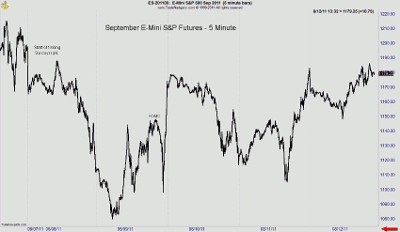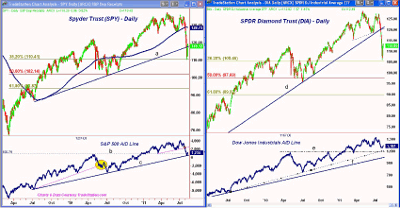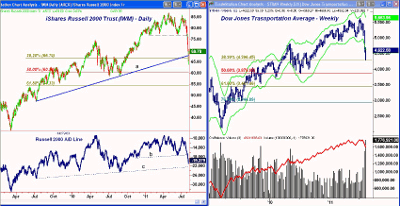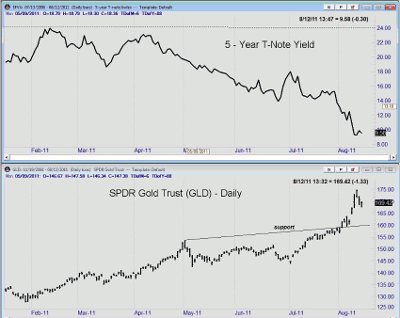Next week should prove quieter, but with all the uncertainty weighing on the markets, it’s probably best to get defensive and wait for possible buying opportunities later on, writes MoneyShow.com senior editor Tom Aspray.
Traders in the past have complained about the lack of price movement in the summer, as it means that there are fewer decent price swings to trade, therefore fewer opportunities. This had started to change over the past few years…but should never be heard after last week’s action.
There were so many factors that buffeted the market, in addition to the downgrade by S&P and the FOMC announcement, that it was tough even for seasoned professionals to keep up.
This chart is not my electrocardiogram, but a 5-minute chart of the trading activity in the September Emini S&P futures last week. For those who are not familiar with this futures contract, each point move is equal to $50, so a 40-point move is worth $2,000 on margin of roughly $3,500.
I share this just to illustrate that there were several times last week where if you bought or sold at the wrong time, you could have lost as much as your margin before the day was over.
The most dramatic swing was in reaction to the Fed’s announcements. Futures rallied initially on the prospects of lower rates until 2013, but then plunged below 1,100 when they realized the Fed’s pessimistic view of the economy. Of course, futures quickly recovered, and closed the day sharply higher.
The stock market’s sharp drop over the past few weeks seems due to the opinion of many that that the US economy will get even weaker, and that another recession is now more likely.
If this view is correct, stocks are likely to decline below last week’s lows by a significant amount. If not, it is my opinion that the worst of the selling may be over.
Such a steep decline in just a few weeks is more characteristic of panic sell-off, such as what we saw in 1987, than the some of the sharp drops that were observed in past bear markets. I shared some examples early this week in “Is This the Worst Market Decline?”
If we are heading into another recession, there are no signs yet from the Leading Economic Indicators (LEI), which has had a very good record of signaling past recessions six months in advance.
The economic numbers last week were mixed, and this week there are quite a few economic reports. These reports may give us some additional information on the state of the economy:
- Monday: Empire State Manufacturing Survey and Housing Market Index
- Tuesday: Housing Starts and Industrial Production
- Wednesday: Producer Price Index
- Thursday: Consumer Price Index, Jobless Claims, and the Philadelphia Fed Survey
NEXT: WHAT TO WATCH
|pagebreak|WHAT TO WATCH
The verdict on the stock market is still out, and the market is likely to take a rest this week unless the news from the Eurozone debt crisis gets worse. Since meeting are scheduled next week, and several countries have now prohibited naked short selling, this is somewhat less likely.
Clearly we have a very split market, as those averages that have a large percentage of financial stocks (like the S&P 500) look the weakest, while those with very few (like the Nasdaq-100) look the best.
By many measures, the market is as oversold as it was in October 2008…and even though stocks still went lower, many sectors bottomed at the end of 2008.
Of the major averages, only the small cap Russell 2000 has convincingly broken its 38.2% support from the bear-market lows in 2009. For those not familiar with this analysis, if the 38.2% level is broken, it is likely that the market will drop to the 50% support levels.
To read more, see yesterday’s Trading Lesson on Fibonacci analysis.
A broad trading range is likely, as those bearish on the market are looking for a rally to the 1,200 to 1,220 area on the S&P 500 or $120.50 to $122 on the Spyder Trust (SPY) to establish short positions.
Even if the worst of the selling is behind us, I would still expect some backing and filling, with one (if not more) drops back to last week’s lows likely before a sustainable rally is possible. It the A/D lines start to drop faster than prices, it will suggest another sharp decline is likely.
S&P 500
The Spyder Trust (SPY) slightly violated the major 38.2% support at $110.41 on Tuesday and broke below the weekly uptrend (line a). Friday’s rally brought it back above this trend line, which is a slight plus.
The S&P 500 A/D line violated its short-term support several weeks ago, but has turned up from its long term support (line c). It has also tested the highs from 2010 (line b), which would be expected to provide support.
If the SPY can surpass initial resistance in the $120.50 to $121 area, the $124 to $125.50 level will become more difficult to overcome.
Dow Industrials
The Spyder Diamonds Trust (DIA) has so far held above its 38.2% support of $105.46, as last week’s low was $105.94. The uptrend from the 2009 lows (line d) has been broken, and this now represents major resistance in the $118 to $120 area.
A few weeks ago, I mentioned the head-and-shoulders top in the DIA, and the downside targets from this formation have already been exceeded.
The Dow Industrials’ A/D line is acting much better than the S&P 500 A/D line, as it is holding above both of its uptrends (line f). It is also holding above the support from 2010 (line e).
If stocks are going to resume their uptrend, the big-cap Dow stocks should do well.
NEXT: Nasdaq-100
|pagebreak|Nasdaq-100
The tech sector has continued to hold up the best, as I discussed earlier today. The PowerShares QQQ Trust (QQQ) is holding above the uptrend from the 2010 lows, and is well above the major 38.2% support at $46.54.
The QQQ came close to closing the week higher, and the best fundamental case can be made for some of the tech stocks, as many have strong earnings and lots of cash. The Nasdaq-100 A/D line is also holding above the March 2011 lows, unlike the other major market averages.
There is next strong resistance at $54.40 to $55.30, and then major levels at $56.60.
Russell 2000
The iShares Russell 2000 Index Fund (IWM) was hit the hardest last week, as it dropped well below the 38.2% support at $66.74 with the week’s low at $63.76. This makes a decline to the 50% support at $60.54 more likely.
IWM was able to close back above its uptrend (line a), but still expect the small caps to underperform.
The Russell 2000 A/D line is finally acting stronger than prices, as it is holding well above the major support (line c). It broke the yearlong support (line b) the prior week.
Sector Focus
The Dow Jones Transportation Average warned us of the recent drop, as the on-balance-volume (OBV) analysis warned of a top in July.
The major 38.2% support at 4,296 was slightly exceeded last week, and a weekly close below it would signal a drop to the 50% support at 3,878.
The Transports have traded well below the weekly starc- bands for the past two weeks, which signaled that selling at the recent lows had a high risk. There is major resistance now in the 4,900 to 5,000 area.
There was heavy volume selling in all of the major sectors, as all dropped sharply, and the 50-day MA is below the 200-day MA for all the major sectors. This is a negative sign, and will require a sharp rally by early in the fall to reverse.
Oil
The energy sector looks the most attractive from an intermediate-term perspective, as the outlook for crude oil over the next year is positive despite its recent sharp drop.
October crude oil is getting very close to the long-term support in the $76 to $78 area, where I would expect prices to stabilize. The oil equipment and services stocks also show better relative performance, or RS analysis, so I will be watching them closely.
NEXT: Interest Rates
|pagebreak|Interest Rates
The most dramatic move last week after the plunge in stock prices was the sharp drop in rates, especially the short-term rates. Clearly the downgrade of US debt was trumped by the Fed’s new positions on rates.
The chart above shows that the yield on the five-year Treasury has dropped well below 1%, closing at 0.94%. This has further reinforced the clear downtrend in yields, as they are back to levels last seen at the height of the financial crisis in October 2008.
Precious Metals
Gold prices also skyrocketed, as the SPDR Gold Trust (GLD) came very close to the $175 level. GLD closed well off the highs, and the initial raising of margin rates on gold futures could signal the start of a well-overdue correction.
Typically it will take another 1 or 2 hikes in the margin requirements before a top is completed, but this should be watched over the next few weeks.
GLD has traded above both its weekly and monthly starc+ bands for a few weeks, which means that even though prices can go higher, the risk is high on the long side.
The iShares Silver Trust (SLV) is still range-bound, and of course it is more economically sensitive, so if gold should top out it may be much more vulnerable. There is first support at $36, with more important levels at $34.
The Week Ahead
Instead of another rollercoaster rise this week, I expect a gentler ride…though the price range may still be quite wide. If you have some stocks that have been acting weaker than the market, I would use a rally towards 1,200 to 1,220 in the S&P to get out of them.
However, even if we have begun a new bear market, I still favor some of the cash-heavy, high-yielding stocks—especially if they get close to last week’s lows, where some panic selling occurred. With yields on money markets or Treasuries so low, they look like much more attractive investments, especially if long-term rates drop any further.
I featured two big drug stocks last week and some overseas utility companies, which will give you an idea of what I am looking for.
I am a bit more wary of the very-high-yielding stocks, as their debt will be more vulnerable if the economy does enter a recession. If you are tempted by 16% to 20% yields, remember: high yield means high risk. So please use stops.






















